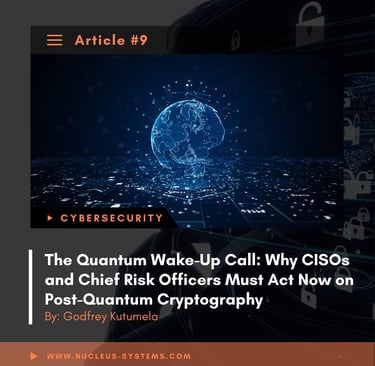Why CISOs and Chief Risk Officers Must Act Now on Post-Quantum Cryptography
Quantum computing is advancing rapidly, putting today’s encryption methods at risk and creating a looming cybersecurity gap for organisations worldwide. This article explains why CISOs and Chief Risk Officers must act now on Post-Quantum Cryptography (PQC) before regulations catch up. Explore the accelerating quantum threat, the limitations of regulatory mandates, the technical complexity of PQC adoption, and the competitive advantage of becoming quantum-ready early. A proactive strategy today will define your organisation’s resilience in the quantum era.
Godfrey Kutumela
11/18/20254 min read


In the rapidly evolving world of cybersecurity, a new technological threat looms: quantum computing. Although quantum computers capable of breaking traditional cryptographic systems are still in their infancy, experts agree that their development will render many of today’s encryption methods obsolete. As the global cybersecurity landscape prepares for this quantum leap, organizations have a unique opportunity to act proactively. The key question remains: Will you lead the transition to Post-Quantum Cryptography (PQC), or will you wait until regulations force you to catch up?
The PQC Gap: A Looming Cybersecurity Crisis
The field of Post-Quantum Cryptography is still maturing. As of now, no global regulatory mandates have been established for implementing quantum-safe encryption. NIST (National Institute of Standards and Technology) is finalizing standards to develop quantum-resistant algorithms. However, these standards are still years away from full adoption.
For now, there is no immediate compliance requirement for organizations to adopt PQC solutions. However, this creates a false sense of security, as if the quantum threat is too far in the future to warrant attention today. But waiting for regulations, or worse, reacting to them when they eventually arrive, could place organizations at significant risk. Regulations typically lag behind technological advancements and rarely capture the technical nuances of the rapidly changing cybersecurity landscape.
For Chief Information Security Officers (CISOs) and Chief Risk Officers (CROs), the need to act now on PQC is urgent. Here’s why:
1. Quantum Computing Is Coming, And It’s Moving Fast
While the practical application of quantum computers to break cryptographic systems might not be here yet, research into quantum technologies is accelerating. Governments and private organizations are investing billions of dollars into quantum research. China, the United States, Russia, and the European Union are all racing to develop quantum-resistant technologies, and some countries have already demonstrated quantum-secure communication methods.
For many organizations, this is not a matter of if quantum computers will break encryption, but when. Given the pace of quantum research and development, it is only a matter of time before quantum computers surpass current encryption technologies.
This means that organizations that delay their PQC preparations may find themselves ill-equipped to handle an abrupt transition to quantum-safe cryptography when quantum capabilities finally materialize.
2. Regulations Are Coming—But They Won’t Be Enough
Globally, we are already seeing the first movements toward regulatory frameworks that may eventually require the adoption of quantum-safe cryptography. The NIST PQC standardization process is progressing steadily, but these standards, once finalized, will likely serve as the basis for regulatory mandates, particularly in the United States. Similarly, the European Union has laid the groundwork with initiatives such as the Cybersecurity Act and GDPR, which could be adapted to include quantum-resistant protocols once the threat becomes more imminent.
However, these regulations often come with a critical flaw: they rarely account for the technical intricacies of the cybersecurity landscape. Regulations tend to be high-level and generic, focusing on compliance rather than practical security concerns. This is especially true for emerging technologies like quantum computing. By the time regulations are enacted, organizations may be forced into a mad scramble to deploy solutions that are technologically unsuited to their unique needs.
Furthermore, regulatory timelines can often lack urgency. Regulators may only require the adoption of quantum-safe measures after quantum threats have materialized, creating a window of vulnerability. CISOs and CROs must ask themselves: Do you want to be forced into compliance once it’s too late, or do you want to be ahead of the curve?
3. Regulatory Mandates Are Reactive, Not Proactive
History has shown that regulations tend to react to security breaches rather than prevent them. Think about the rise of data privacy regulations, such as GDPR, in response to massive violations or the Cybersecurity Information Sharing Act (CISA) following high-profile cyberattacks. By the time these regulations were enforced, many organizations had already suffered significant damage. The same could happen with PQC.
In contrast, adopting a proactive approach to PQC offers several advantages:
Mitigating risk before quantum threats become a reality: By beginning your PQC transition now, you safeguard your data and systems against future risks. You’ll be ahead of competitors and more resilient to quantum-driven attacks when they emerge.
Fostering trust and transparency with clients and partners: Demonstrating that you are taking a proactive stance in preparing for quantum threats will enhance your organization’s credibility and reputation in an increasingly security-conscious market.
Reducing the cost of transition: When quantum-safe algorithms become a regulatory requirement, there will be significant costs and disruptions as organizations scramble to update their infrastructure. By acting early, you can spread out costs and minimize business disruptions.
4. The Technical Complexity of the PQC Transition
Moving to PQC is not as simple as flipping a switch. It requires careful evaluation of existing cryptographic systems, understanding your organization's specific needs, and selecting the most suitable quantum-safe algorithms. The technical intricacies of this process are not well-suited to generic regulations, which often fail to account for the unique infrastructure, legacy systems, and application-specific requirements of individual organizations.
For example, quantum-safe solutions might require larger key sizes, new encryption algorithms, or even the integration of hybrid cryptographic approaches. This process will require in-depth knowledge of:
Current cryptographic dependencies across your organization,
The performance impact of deploying new cryptographic systems,
The interoperability between quantum-safe algorithms and legacy systems.
A piecemeal approach, driven by compliance deadlines, may lead to incompatibilities, security gaps, or unintended vulnerabilities. Technical experts in cybersecurity and cryptography will need to be involved early to map out a sustainable path forward.
5. The Competitive Edge: Quantum-Ready Is Cyber-Resilient
Preparing for PQC can be a competitive differentiator. Organizations that adopt quantum-resistant solutions early will not only be more secure but also gain a reputation for being forward-thinking and resilient. This can help attract clients, retain investors, and secure sensitive data in an era where data breaches are ever more costly.
Conversely, failure to act could result in severe consequences: data breaches, reputational damage, regulatory penalties, and loss of customer trust. These are all avoidable if organizations take a proactive stance today.
Conclusion: Close the PQC Gap Before It’s Too Late
CISOs and Chief Risk Officers face a critical juncture. The window to prepare for quantum-safe cryptography is closing, and waiting for regulations to force your hand could expose your organization to significant risks. As quantum computing advances, the implications for cybersecurity will be profound, and the failure to act early will come at a heavy cost.
Instead of waiting for regulations to catch up with the technology, take control now and begin transitioning to PQC solutions. The cost of inaction far outweighs the investment in a quantum-secure future, both in terms of reputation and risk management.
Be proactive. Be resilient. Be quantum-ready. Your organization’s cybersecurity future depends on it.
